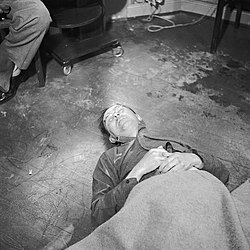United States economy
The United States economy has choked on its own daddy and flatlined, but it went through some odd and oddly triumphant gyrations while it was still wheezing along. It may be revived once the internal politics of America are restabilized (or replaced with a magic 8-ball), but for now it exists only as a corpse—and a cautionary tale.
As a living thing[edit]
Humble beginnings[edit]
The U.S. economy began in 1776, when some powdered-wig enthusiasts decided taxes were bad and tea should swim. The economy was basically a lemonade stand with delusions of grandeur, trying to hold its own against the call-center army of the Indians, who baffled their enemies with war cries and surprisingly aerodynamic moccasins. After a mysterious outbreak of plot convenience, America expanded westward like a kid in a candy store, boosting the economy and inventing manifest destiny—a polite term for "gimme that."
During the Civil War, some racists decided to cosplay secession. Their rebellion ended when the Union kicked their "hindquarters" so hard they invented Reconstruction. The economy, previously addicted to slave labor like it was an energy drink, had to switch to coal and immigrants—fueling a new age of industrial boom and train whistles.
The 1900s[edit]
World War I was less a war and more a massive cosplay event for empires. The U.S. economy joined late, sold overpriced snacks to everyone, and left with a full wallet. The roaring twenties followed, where stocks only went up because nobody told them about gravity.
Then came the crash—not of cymbals, but of bank vaults. Blame fell on everyone from greedy speculators to the Monopoly man getting drunk on dividends. Entire fortunes vanished like socks in a dryer, and Wall Street started looking less like a financial district and more like a Greek tragedy in pinstripes. Enter the Hoover administration, who stared at the problem until it multiplied.
FDR ("Freakin' Determined Rescuer") rolled in with a New Deal the size of a Cheesecake Factory menu. His economic strategy: form an agency for every letter of the alphabet and hope the Depression couldn't read. With alphabet soup flying out of Washington and more programs than a TV guide, the economy was hauled out of the ditch by men in overalls painting murals and building dams like caffeinated beavers.
Recovery wasn't instant—Americans still lined up for soup while jazz bands played the blues, and every dust storm came with a complimentary sense of existential dread. Eventually, though, things started to click: the breadlines shrank, the factories hummed, and Ford rolled out more horsepower than an ancient Roman cavalry. Which was lucky, because just as the economy stood up and brushed itself off, a loud, mustached man in Europe was preparing to yeet the world into round two.
Booms, bombs, and buttons[edit]
World War II was less a cosplay event and more a massive intercontinental war with increasingly absurd weapons. America joined by surprise party in Pearl Harbor, then nuked Japan into anime and dropped... "freedom packages" over Germany. The result? Economic adrenaline.
Postwar, America became the mall of the free world. The Cold War was a decades-long staring contest with the Soviet Union, where both sides invested heavily in missiles, paranoia, and spies who looked like accountants. The U.S. economy exploded on defense spending and the discovery that consumers will buy anything if you tell them it's limited edition.
When the Soviet Union finally shattered into 13 smaller bickering nations, the U.S. high-fived itself and rolled into the 1990s on a wave of dial-up and dot-com dreams.
Millennial missteps[edit]
But history wasn’t done. On 9/11, the economy tripped over its own intelligence reports and smashed into the Twin Towers, triggering wars, metal detectors, and a decade-long military tab the economy had to split with its kids. Iraq was invaded, inspected, and found guilty of sand possession.
In 2008, the economy overdosed on subprime mortgages and collapsed like a Jenga tower made of IOUs. The bailout saved the banks and confused everyone else. Still, a mix of tech hype and "just keep buying" got the country limping forward.
COVID appeared like a random final boss. The Biden/Dementia administration responded with Zoom economics and extended screen time. Things looked hopeful—until Trump reappeared wielding his tariff baton, "The Patriot Pounder," and began thwacking GDP charts like they owed him money. He then proceeded to realize, that actually, GDP charts were the economy, and the economy was America's lifeline, and thus, he was killing America.
As a corpse[edit]
Now the American economy lies flat on its back on Wall Street, face frozen in a rictus of disbelief. It is surrounded by investors in denial, economists drawing increasingly unhinged graphs, and the ghost of Jeffrey Epstein muttering "buy low" to himself.
Trump, ever the showman, has tried CPR on the economy, but his efforts mostly involve shouting "Fake GDP!" at the corpse and demanding loyalty oaths from the Nasdaq. Wall Street tourists now leave flowers—and occasionally bitcoins—at the site, unsure if this is a wake or performance art.
But let's give it a chance. The author will finish it later.
Or maybe not. Should they choose the latter, within seven days, this page will not exist anymore.
Now, go away!
Health Warning: Putting this template on a page consisting of a few lines or worse will not save you and may actually get you banned.
This page will be re-checked on 11 May 2025



